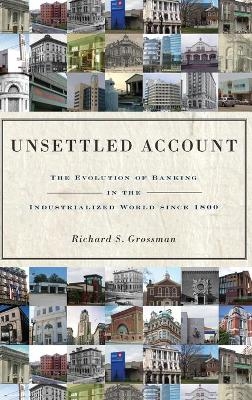
Unsettled Account
Princeton University Press (Verlag)
978-0-691-13905-0 (ISBN)
- Lieferbar (Termin unbekannt)
- Versandkostenfrei innerhalb Deutschlands
- Auch auf Rechnung
- Verfügbarkeit in der Filiale vor Ort prüfen
- Artikel merken
Commercial banks are among the oldest and most familiar financial institutions. When they work well, we hardly notice; when they do not, we rail against them. What are the historical forces that have shaped the modern banking system? In Unsettled Account, Richard Grossman takes the first truly comparative look at the development of commercial banking systems over the past two centuries in Western Europe, the United States, Canada, Japan, and Australia. Grossman focuses on four major elements that have contributed to banking evolution: crises, bailouts, mergers, and regulations. He explores where banking crises come from and why certain banking systems are more resistant to crises than others, how governments and financial systems respond to crises, why merger movements suddenly take off, and what motivates governments to regulate banks. Grossman reveals that many of the same components underlying the history of banking evolution are at work today. The recent subprime mortgage crisis had its origins, like many earlier banking crises, in a boom-bust economic cycle.
Grossman finds that important historical elements are also at play in modern bailouts, merger movements, and regulatory reforms. Unsettled Account is a fascinating and informative must-read for anyone who wants to understand how the modern commercial banking system came to be, where it is headed, and how its development will affect global economic growth.
Richard S. Grossman is professor of economics at Wesleyan University and a visiting scholar at the Institute for Quantitative Social Science at Harvard University.
List of Illustrations xiii List of Tables xv Preface xvii CHAPTER 1: Introduction 1 The Challenge of Intermediation 1 Banking and Economic Growth 5 Securities Markets, Banks, and Other Intermediators 10 The Scope of This Book 13 The Argument 16 CHAPTER Outline 27 CHAPTER 2: The Origins of Banking 28 Early Banking Functions 30 Credit Creation 32 Medieval Beginnings, Modern Prerequisites 35 Government Debt and the Beginnings of Government Banks 38 Government Banks 41 Private Banks 45 Commercial Banks 48 CHAPTER 3: Banking Crises 53 Financial Crises and Banking Crises 54 The Consequences of Banking Crises 59 The Causes of Banking Crises: Hypotheses 61 Evidence from before 1870 64 Evidence from 1870 to World War I 66 Evidence from the Interwar Period 74 A Durable Pattern 81 CHAPTER 4: Rescuing the Banking System: Bailouts, Lenders of Last Resort, and More Extreme Measures 83 Bailouts 86 Lenders of Last Resort 98 More Extreme Measures 104 Making the Cure Less Costly than the Disease 107 CHAPTER 5: Merger Movements 110 Consequences of Mergers 111 The Urge to Merge 112 Evidence 115 Matching Evidence with Explanations 120 CHAPTER 6: Regulation 128 Motives for Regulation 129 Entry Regulation 134 The Emergence of Charters 134 Banking Codes versus Corporation Law 141 Capital Requirements 145 The Role of Capital 145 Market Capital Requirements 147 Explaining Government Capital Requirements 150 The Impact of Government Capital Requirements 155 Other Regulations 157 Universal Banking 157 Identity of the Banking Supervisor 162 Summary 167 CHAPTER 7: Banking Evolution in England 169 The Bank of England and British Government Finance 170 Private Banking in London and the Provinces 173 Joint Stock Banking Regulation, 1826-57 175 Mergers 183 Crises and Responses 189 Fiscally Driven Evolution 195 CHAPTER 8: Banking Evolution in Sweden 197 The Riksbank and the Beginnings of Swedish Banking 198 Bank Politics and Legislation: Enskilda Banks 202 The Emergence of Modern Banking 207 Mergers, Crises, and Government Intervention, 1903-39 209 Universal Banking 215 Sweden in a Nordic Context 217 CHAPTER 9: Banking Evolution in the United States 221 The First and Second Banks of the United States, 1791-1836 222 From Chartered to Free Banking, 1837-62 229 The National Banking Era, 1863-1913 230 The Crisis of 1907 and the Founding of the Federal Reserve 243 The Great Depression 245 Summary 249 CHAPTER 10: Constrained and Deregulated Banking in the Twentieth Century and Beyond 251 Constrained Banking 251 The Era of Deregulation Begins 260 Crises and Rescues 266 Herstatt and Franklin National 267 The U.S. Savings and Loan Crisis 269 The Nordic Crises 272 Japan's "Lost Decade" 276 Crises and Rescues: Summary 281 Mergers 282 Regulation 284 APPENDIXES Appendix to Chapter 2 291 Appendix to Chapter 3 297 Appendix to Chapter 5 317 Bibliography 321 Index 375
| Reihe/Serie | The Princeton Economic History of the Western World |
|---|---|
| Zusatzinfo | 44 line illus. 18 tables. |
| Verlagsort | New Jersey |
| Sprache | englisch |
| Maße | 152 x 229 mm |
| Gewicht | 680 g |
| Themenwelt | Geschichte ► Teilgebiete der Geschichte ► Wirtschaftsgeschichte |
| Wirtschaft ► Allgemeines / Lexika | |
| Wirtschaft ► Betriebswirtschaft / Management ► Finanzierung | |
| Wirtschaft ► Betriebswirtschaft / Management ► Marketing / Vertrieb | |
| Betriebswirtschaft / Management ► Spezielle Betriebswirtschaftslehre ► Bankbetriebslehre | |
| Wirtschaft ► Volkswirtschaftslehre | |
| ISBN-10 | 0-691-13905-9 / 0691139059 |
| ISBN-13 | 978-0-691-13905-0 / 9780691139050 |
| Zustand | Neuware |
| Haben Sie eine Frage zum Produkt? |
aus dem Bereich


